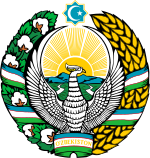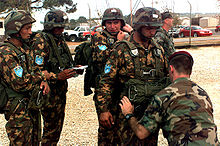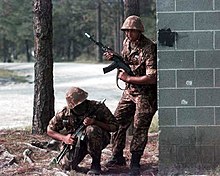Uzbek armed forces
|
|||

|
|||
| guide | |||
|---|---|---|---|
| Commander in Chief : | |||
| Headquarters: | Tashkent | ||
| Military strength | |||
| Active soldiers: | 52,500 ( rank 65 ) | ||
| Conscription: | 12 months (as of 2009) | ||
| Resilient population: | total (men and women; ages 18-49): 5,684,540 men and 6,432,976 women (estimated, as of 2008) |
||
| Eligibility for military service: | 18 years | ||
| household | |||
| Military budget: | $ 902.4 million (as of 2007) | ||
| Share of gross domestic product : | 4.05% | ||
| history | |||
The armed forces of Uzbekistan ( Uzbek O''zbekiston Respublikasi Qurolli Kuchlari ) are among the most important in Central Asia and have around 52,500 soldiers.
Structure and costs
Tashkent - the capital of Uzbekistan - was the headquarters of the Turkestan military district of the Soviet Army . When the country became independent in 1991 with the collapse of the Soviet Union , it adopted this structure. In the later years the Russian and Slavic officers were exchanged for ethnic Uzbeks and the Uzbek military was restructured to meet the new needs of the Uzbek government, such as fighting civil unrest and drug trafficking, as well as persecuting the Islamist Hizb ut-Tahrir and other Islamic- fundamentalist groups.
Between 1992 and 2006, the Uzbek government spent between 0.8% and 3.7% of GDP on its military. In 2007, this increased to 4.8% of GDP and thus the considerable sum of just over 900 million US dollars. For comparison: the budget of the German Bundeswehr is only around 1.22% of GDP (37 billion euros, as of 2017).
The armed forces consist of the land forces, the air and air defense forces, the security forces (internal and border troops) and the National Guard. Due to the lack of connection to the world's oceans, the country only has river forces and no real navy. According to the 1992 Defense Act, the army is only to be used for defensive purposes. Uzbekistan's potential recruits include six million men between the ages of 18 and 49.
structure
The army of 40,000 soldiers is divided into four military areas, two operational commands and the capital command. There are ten motorized rifle brigades , a mountain infantry brigade , one airborne brigade , an air assault brigade , a special task force and a tank brigade present.
The air force comprising 12,500 soldiers is divided into the 59th Fighter-Bomber Regiment (Su-25), the 60th Fighter- Bomber / Reconnaissance Regiment (Su-24 / -24MR), the 61st Multi -Purpose Combat Regiment (MiG-29 / -29UB), the 62nd. Multi-purpose combat pilot regiment (Su-27 / -27UB), a fighter-bomber regiment (Su-25, L-39), the 65th helicopter regiment (Mi-8), the 66th helicopter regiment (Mi-24, Mi-8, Mi-17, Wed -26) and a mixed regiment.
Equipment and troop strength
| Land force (army) | |
| soldiers | 40,000 |
| Main battle tank | |
| T-72 | 79 |
| T-64 | 100 |
| T-62 | 170 |
| T-55 | 80 |
| of which operational | 414 (as of 2007) |
| Armored vehicles | |
| BMP-1 | 180 |
| BMP-2 | 172 |
| BTR-60 | 24 |
| BTR-70 | 36 |
| BTR-80 | 290 |
| BRDM-2 | 13 |
| and more | |
| of which operational | 971 (as of 2007) |
| artillery | |
| 122 mm D-30 | 540 |
| 122 mm D-1 | ? |
| 152 mm D-20 | ? |
| 152 mm 2A36 | 140 |
| 120 mm 2S9 | ? |
| 122 mm 2S1 | 18th |
| 152 mm 2S3 | 17th |
| 203 mm 2S7 | 48 |
| of which operational | 800 |
| Rocket launcher | |
| 122 mm BM-21 degrees | 60 |
| 220 mm BM-27 Uragan | 49 |
| of which operational | 115 |
| Air Force | |
| soldiers | 12,500 |
| Warplanes | |
| MiG-29 | 32 |
| Su-27 | 25th |
| Su-24 | 31 |
| Su-17 | 26th |
| of which operational | 80 |
| Transport aircraft | |
| Il-76 , AN-24 , An-12 , Tu-134 | |
| total | 27 |
| Combat helicopter | |
| Wed-24 | 29 |
| Wed-8 / Wed-17 | 52 |
| of which operational | 52 (as of 2007) |
| Transport helicopter | |
| Mil Wed-6 | 26th |
| Mil Wed-26 | 1 |
| total | 27 |
Activities and External Relations
Gun controls and de-escalation
The government has approved the gun control requirements of the former Soviet Union as well as the Nuclear Non-Proliferation Treaty and supported an active program of the Defense Threat Reduction Agency (DTRA) in western Uzbekistan in the Nukus area and on the Island of Rebirth (Uzbek: Tiklanish orollari, Russian: Ostrow Wosroschdenija) in the Aral Sea . The latter is primarily related to research on biological weapons in the years from 1948 onwards by the Soviet military.
Relations with the USA

After September 11, 2001, the US leased a military base on the Qarshi - Chanabad route , which is near the Afghan border.
A joint declaration by the states of the Shanghai Cooperation Organization from early July 2005 at a conference in Astana ( Kazakhstan ) called for the withdrawal of US troops from Central Asia. On July 29, 2005, Uzbekistan issued a regulation that US forces had to leave the country within 180 days. On November 21, 2005, the withdrawal of American troops stationed in Uzbekistan was complete.
New negotiations in February 2009 led to an agreement on the transport of non-military supplies by container via Uzbekistan to Mazar-e Sharif in Afghanistan .
European Union stops arms sales
In 2005 the EU stopped arms sales and imposed one-year residency bans on twelve senior officers, as well as the security chief and ministers of home affairs and defense, on charges of responsibility for the Andijon war crimes . The arms embargo was lifted at the end of 2009
Russian-Uzbek military alliance
In 2004 the first Russian-Uzbek maneuver took place in Uzbekistan. It was the first time since the collapse of the Soviet Union that Russian troops moved within the borders of Uzbekistan.
In June 2004, Uzbekistan and Russia signed an agreement on a strategic partnership which, in addition to cooperation in security policy, also provides for arms deliveries and further cooperation.
As a next step, Russia and Uzbekistan signed a joint defense alliance in November 2005, which will, among other things, result in closer military cooperation and provide support in the event of a defense. Russia supplies arms to the army and trains its soldiers. All of this shows the change in Uzbek foreign policy in recent years. Before that, the US had been Uzbekistan's preferred partner. Relations with Russia have so far been characterized by a rather cool distance.
Human rights violations
In the Uzbek army it happens quite often that officers there harass their subordinates to an extreme degree, mostly by extorting part of their wages from them. Soldiers who refused to do so are said to have suffered severe torture and the resulting deaths.
When around 1,000 armed Islamist fighters invaded from Kyrgyzstan in the summer of 1999 , the government is said to have sent only officer cadets for defense and not regular troops. The reason is said to have been the fear of the Uzbek government that the soldiers would take revenge on their superiors on this occasion.
In May 2005, the military participated in the suppression of the Ferghana Valley uprisings in Andijon .
literature
- The World Defense Almanac 2006 . Mönch Publishing Group, Bonn 2006
- IISS Military Balance 2007
- The Fargana Valley Uprising . In: Die Zeit , No. 20/2005
